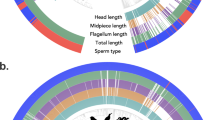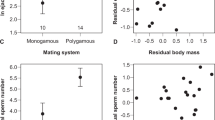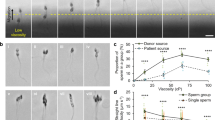Abstract
In animals with multiple-partner mating systems, the gametes of two or more males must compete to fertilize a given set of ova1,2,3,4,5. Here we show that the volume of the midpiece in individual sperm is significantly greater in primate species in which the females mate with multiple partners, and in which males have larger testes in relation to their body weight, than in those species that mate with only one partner and have relatively small testes. Our results indicate that sexual selection by sperm competition has influenced the evolution of a specific component of male-gamete morphology, the volume of the sperm midpiece.
Similar content being viewed by others
Main
We classified different primate species as having either a single- or multiple-partner mating system on the basis of published descriptions of primary mating systems and behavioural information6,7. We measured the lengths (in µm) and volumes (in µm3) of sperm head, midpiece and flagellum in 31 species, representing 21 primate genera. We compared differences in sperm morphology between single- and multiple-partner mating systems at both the genus and species levels, using comparative analysis of independent contrasts (CAIC)8. Critical α-levels were adjusted for multiple comparisons of sperm traits using the sequential Bonferroni technique.
Sperm lengths did not differ statistically between single- and multiple-partner mating systems. By contrast, sperm midpiece volumes differed significantly at both the genus (F = 20.86, P < 0.01) and species (F = 3.46, P < 0.05) levels (Fig. 1a). When sperm-head volumes associated with single- and multiple-partner mating systems were compared, there was no significant difference between genera or species (44.01 ± 2.71 µm3 versus 41.82 ± 2.40 µm3, and 46.20 ± 3.2 µm3 versus 44.56 ± 2.89 µm3, respectively). The same was true for flagellum volumes (9.74 ± 0.82 µm3 versus 9.73 ± 1.21 µm3, and 8.01 ± 0.81 µm3 versus 9.69 ± 0.88 µm3, respectively).
a, Comparison of sperm midpiece volume in primates with single-partner (black bars) or multiple-partner (white bars) mating systems at the genus level (top) and the species level (bottom; after comparative analysis of independent contrasts, CAIC). Numbers in bars show sample sizes (number of animals). Asterisk denotes P < 0.01; double asterisk denotes P < 0.05 (tablewide α-values maintained by sequential Bonferroni corrections). One hundred sperm from each of 106 specimens were measured at × 1,000 magnification using a light-refractive microscope, a digital camera and Image NIH for Apple Macintosh. Midpiece volume was estimated using the formula for calculating the volume of a cylinder (π × midpiece width2 × midpiece length). b, Midpiece volume (in µm3) in relation to relative testis size in 21 primate genera (y = 2.55x + 7.52; P < 0.0001). 1, Gorilla; 2, Erythrocebus; 3, Callithrix; 4, Hylobates; 5, Pongo; 6, Theropithecus; 7, Saimiri; 8, Cebus; 9, Galago; 10, Homo; 11, Cercopithecus; 12, Lophocebus; 13, Mandrillus; 14, Pygathrix; 15, Lemur; 16, Eulemur; 17, Papio; 18, Nycticebus; 19, Microcebus; 20, Pan; 21, Macaca.
Because there is disagreement over the classification of primate mating systems, we also used relative testis weight as an indirect measure of likely sperm competition. We calculated residual values of testis weight from a regression plot of combined testes weight against body weight. We compared genera with relatively small testes (negative residuals) with those with relatively large testes (positive residuals). Midpiece volumes were significantly greater in sperm from primate genera with relatively large testes (mean ± s.e.m.: 9.758 ± 0.558 µm3 for genera with large testes; 5.360 ± 0.609 µm3 for genera with small testes; t = − 4.57, P < 0.001). No significant difference was found when the analysis was repeated for sperm-head volume and flagellum volume.
We also tested for a possible correlation between relative testis weight and sperm midpiece volume, and found a strong effect (r2 = 0.49, P < 0.0001; Fig.1b), although none of the other variables examined was correlated with relative testis weight. We conclude that sexual selection has probably influenced midpiece volume as well as testicular size.
Certain features of midpiece anatomy are highly heritable9. The volume of the midpiece is a more informative measure than its length, as this section contains a densely packed, helical array of mitochondria which provides energy for motility in the absence of glycolytic support10,11. The volume is therefore a likely indicator of the degree of mitochondrial loading.
Mitochondrial loading also has a bearing on flagellar hydrodynamics10,11, and the ATP content of the sperm of domestic fowl is positively correlated with its motility12. The greater midpiece volumes we have observed in primates with multiple-partner mating systems, in which sperm competition is most prevalent, may therefore result from selection for increased mitochondrial loading and greater motility. This would mirror the situation in domestic fowl, in which high sperm motility is correlated with successful sperm competition13.
References
Parker, G. A. in Sperm Competition and the Evolution of Animal Mating Systems (ed. Smith, R. L.) 1–60 (Academic, Orlando, 1984).
Birkhead, T. R. & Møller, A. P. Sperm Competition and Sexual Selection (Academic, London, 1998).
Short, R. V. Adv. Study Behav. 9, 131–158 (1979).
Harcourt, A. H., Harvey, P. H., Larson, S. G. & Short, R. V. Nature 293, 55–57 (1981).
Birkhead, T. R. Promiscuity: An Evolutionary History of Sperm Competition and Sexual Conflict (Faber & Faber, London, 2000).
Dixson, A. F. Primate Sexuality: Comparative Studies of the Prosimians, Monkeys, Apes and Human Beings (Oxford Univ. Press, New York, 1998).
Smuts, B. B., Cheney, D. L., Seyfarth, R. M., Wrangham, R. W. & Struhsaker, T. T. Primate Societies (Univ. Chicago Press, Chicago, 1987).
Purvis, A. & Rambout, A. Cabios 11, 247–251 (1995).
Woolley, D. M. & Beatty, R. A. Nature 215, 94–95 (1967).
Cardullo, R. A. & Baltz, J. M. Cell. Motil. Cytoskeleton 19, 180–188 (1991).
Katz, D. F. & Drobnis, E. Z. in Fertilization in Mammals (eds Bavister, B. D., Cummins, J. & Roldan, E. R. S.) 125–137 (Serono Symp., Norwell, Massachusetts, 1990).
Froman, D. P. & Feltmann, A. J. Biol. Reprod. 58, 379–384 (1998).
Birkhead, T. R., Martinez, J. G., Burke, T. & Froman, D. P. Proc. R. Soc. Lond. B 266, 1759–1764 (1999).
Author information
Authors and Affiliations
Rights and permissions
About this article
Cite this article
Anderson, M., Dixson, A. Motility and the midpiece in primates. Nature 416, 496 (2002). https://doi.org/10.1038/416496a
Issue Date:
DOI: https://doi.org/10.1038/416496a
This article is cited by
-
Population-specific, recent positive directional selection suggests adaptation of human male reproductive genes to different environmental conditions
BMC Evolutionary Biology (2020)
-
The development, evaluation, and illustration of a timeline procedure for testing the role of sperm competition in the evolution of sexual traits using paternity data
Behavioral Ecology and Sociobiology (2020)
-
Comparative analysis of mammalian sperm ultrastructure reveals relationships between sperm morphology, mitochondrial functions and motility
Reproductive Biology and Endocrinology (2019)
-
Sexual Attractiveness: a Comparative Approach to Morphological, Behavioral and Neurophysiological Aspects of Sexual Signaling in Women and Nonhuman Primate Females
Adaptive Human Behavior and Physiology (2019)
-
Rival seminal fluid induces enhanced sperm motility in a polyandrous ant
BMC Evolutionary Biology (2018)
Comments
By submitting a comment you agree to abide by our Terms and Community Guidelines. If you find something abusive or that does not comply with our terms or guidelines please flag it as inappropriate.




